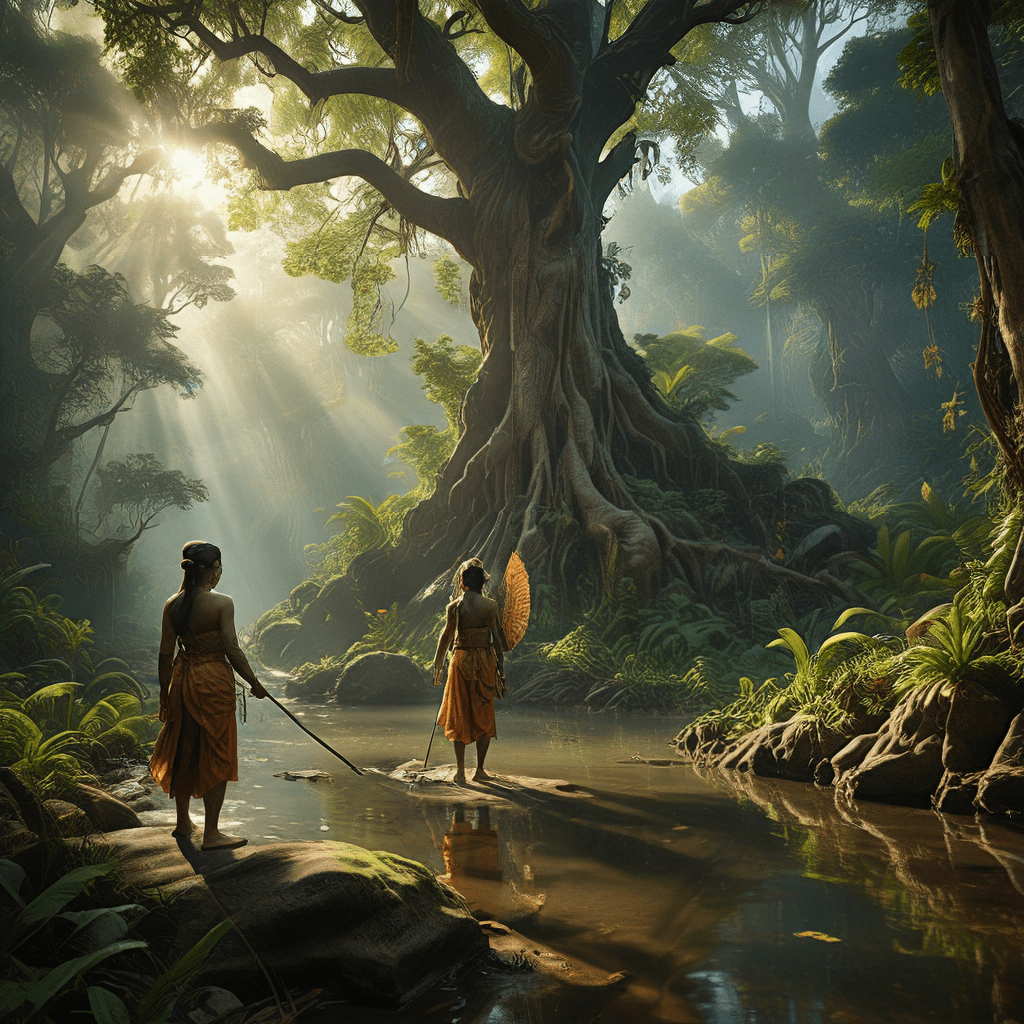The Intertwined Tapestry of Nature and Mythology in Indonesian Lore
The Indonesian archipelago, a sprawling chain of islands stretching across the equator, boasts a breathtaking tapestry of natural wonders. From towering volcanoes to lush rainforests, from shimmering coral reefs to vast rice paddies, the landscape is a symphony of vibrant colours and textures. This intricate interplay between land, water, and sky has profoundly shaped Indonesian mythology, weaving a rich narrative where nature and legend intertwine.
Indonesian Mythology: A Realm of Divine Beings and Natural Phenomena
Indonesian mythology is a vibrant tapestry of ancient beliefs, oral traditions, and mythical narratives passed down through generations. At the heart of this rich legacy lie stories of deified spirits, mythological creatures, and divine beings intricately woven into the fabric of nature. These tales encapsulate the deep respect and reverence that Indonesians have for the natural world, reflecting a profound understanding of its power and influence.
These myths offer explanations for the origin of the world, the cycle of seasons, and the forces that govern nature. They serve as moral guides, underscoring the importance of harmony with nature and the consequences of human actions. The stories are often rooted in tangible elements of the natural world, such as mountains, rivers, forests, and animals, showcasing a profound connection between the physical and spiritual realms.
The Cosmic Dance of Nature’s Elements in Indonesian Mythology
Across the Indonesian archipelago, the elements of nature play a pivotal role in mythology. The earth, represented by the powerful goddess Dewi Bumi, is revered as the source of life and sustenance. The vast oceans, ruled by the mighty Nyai Roro Kidul, embody both the beauty and the dangers of the sea. The sky, a realm of deities and celestial beings, is often depicted as a source of divine power and the embodiment of the divine order.
The interplay between these elements in myth reflects the complex and dynamic relationship Indonesians have with nature. Their understanding of the natural world is not merely based on observation but also on a deep spiritual connection, where every element holds a unique significance and power.
The Sacred Mountains, Rivers, and Forests: Embodiments of Divine Power
In Indonesian mythology, many geographical features are associated with divine beings and supernatural powers. Mountains, often viewed as the abode of the gods, are revered as sacred sites, their peaks reaching towards the heavens and their slopes nurturing verdant forests. The majestic Mount Merapi, for instance, is considered the dwelling place of the powerful spirits who guide and protect the surrounding communities.
Rivers, the lifelines of the land, are also imbued with spiritual significance. They are often personified as deities who regulate the flow of water and ensure its purity. The sacred river Ganges in Java, for example, is believed to possess healing powers and is a site of pilgrimage for many. Forests, teeming with diverse flora and fauna, are often seen as mystical realms inhabited by spirits, mythical creatures, and powerful forces. They are viewed as places of refuge, sources of wisdom, and repositories of ancient knowledge.
Mythological Creatures of the Indonesian Archipelago: Guardians of the Natural World
The Indonesian archipelago is also home to a fascinating array of mythological creatures, each with its own unique powers and symbolism. These creatures, often depicted as guardians of the natural world, embody the intricate relationship between humans and the environment.
The majestic garuda, for example, a mythical bird with human-like features, is often revered as a symbol of strength, power, and wisdom. In some myths, it serves as a mount for the gods, representing the connection between the divine and the earthly realm. The mischievous kera, a mischievous monkey-like creature, is often portrayed as a trickster figure who tests the boundaries of the natural world, reminding humans of the importance of respecting the delicate balance of nature.
The Harmony of Nature and the Supernatural: A Cornerstone of Indonesian Beliefs
Indonesian mythology underscores the intimate connection between the natural world and the supernatural realm, highlighting the importance of maintaining harmony between humans and their environment. Many myths emphasize the consequences of disrupting this balance, often depicting natural disasters or societal unrest as a result of human actions that disrespect or abuse nature.
The concept of "keharmonisan" (harmony) is central to this belief system, emphasizing the interconnectedness of all things, both natural and supernatural. Indonesians believe that the natural world is not merely a backdrop for human life but an active and powerful force that requires respect and reverence. This understanding is reflected in traditional practices such as offerings to spirits, rituals to appease deities, and ceremonies to celebrate the abundance of the harvest.
The Role of Nature in Shaping Indonesian Mythological Narratives
Nature plays a crucial role in shaping the narrative structure and symbolism of Indonesian myths. The stories often unfold in specific geographical settings, incorporating local flora and fauna, weather patterns, and geographical features into the plot. This grounding in the natural world makes the myths both relatable and meaningful to those who live in the Indonesian archipelago.
Take, for example, the myth of Sangkuriang, a tale that incorporates the natural features of Mount Tangkuban Perahu (a volcanic mountain in West Java) and the river Citarum. The legend depicts how Sangkuriang's anger and hubris led to the creation of the mountain, transforming it from a boat into a geological marvel. This myth serves as a cautionary tale about the consequences of human arrogance and the importance of respecting natural forces.
The Influence of Nature on Indonesian Rituals and Ceremonies
Indonesian rituals and ceremonies often reflect a deep reverence for nature, incorporating elements of the natural world into their practices. Traditional agricultural ceremonies, for example, often involve offerings to the spirits of the land and water, seeking blessings for a bountiful harvest. Ceremonies associated with the sea, such as those performed before fishing expeditions or during maritime festivals, involve offering prayers to sea deities for protection and good fortune.
These rituals serve as a reminder of the interdependence between humans and nature, acknowledging the role of natural forces in shaping human lives. They also promote a sense of community and shared responsibility for the well-being of the environment.
The Enduring Legacy of Nature in Contemporary Indonesian Culture
The interplay between nature and mythology continues to shape Indonesian culture in the present day. Many traditional arts and crafts, such as weaving, woodcarving, and batik, draw inspiration from the natural world, incorporating motifs of flora, fauna, and natural phenomena.
The reverence for nature is also reflected in contemporary environmental movements and the growing awareness of the importance of sustainability and conservation. In many Indonesian cities, traditional knowledge about herbal medicine, sustainable agriculture, and traditional ecological practices is being revitalized and integrated into modern approaches to environmental stewardship.
Theorizing Nature and Mythology in Indonesian Lore: A Comparative Perspective
The connection between nature and mythology in Indonesian lore provides valuable insights into human perceptions of the environment worldwide. Comparing Indonesian mythology with other belief systems from around the world reveals shared themes and understandings about the relationship between humanity and the natural world.
By examining the diverse approaches to this relationship, we can better appreciate the complexity and richness of human responses to the environment and foster a greater appreciation for the role of mythology in shaping cultural perspectives.
FAQs
Q: What are some of the most important natural elements in Indonesian mythology?
A: The most important elements include Earth, represented by Dewi Bumi, the oceans ruled by Nyai Roro Kidul, and the sky, a realm of deities and celestial beings.
Q: How do Indonesian myths explain natural phenomena?
A: Myths often offer explanations for the cycle of seasons, the origin of the world, and the forces that govern nature. They can also serve as moral guides, highlighting the importance of respecting nature.
Q: What is the significance of sacred mountains in Indonesian mythology?
A: Mountains are often viewed as the abode of the gods and are revered as sacred sites. They are believed to be powerful and hold deep spiritual significance.
Q: How are mythical creatures incorporated into Indonesian mythology?
A: Mythical creatures, such as the garuda and the kera, are often seen as guardians of the natural world, representing the intricate relationship between humans and the environment.



